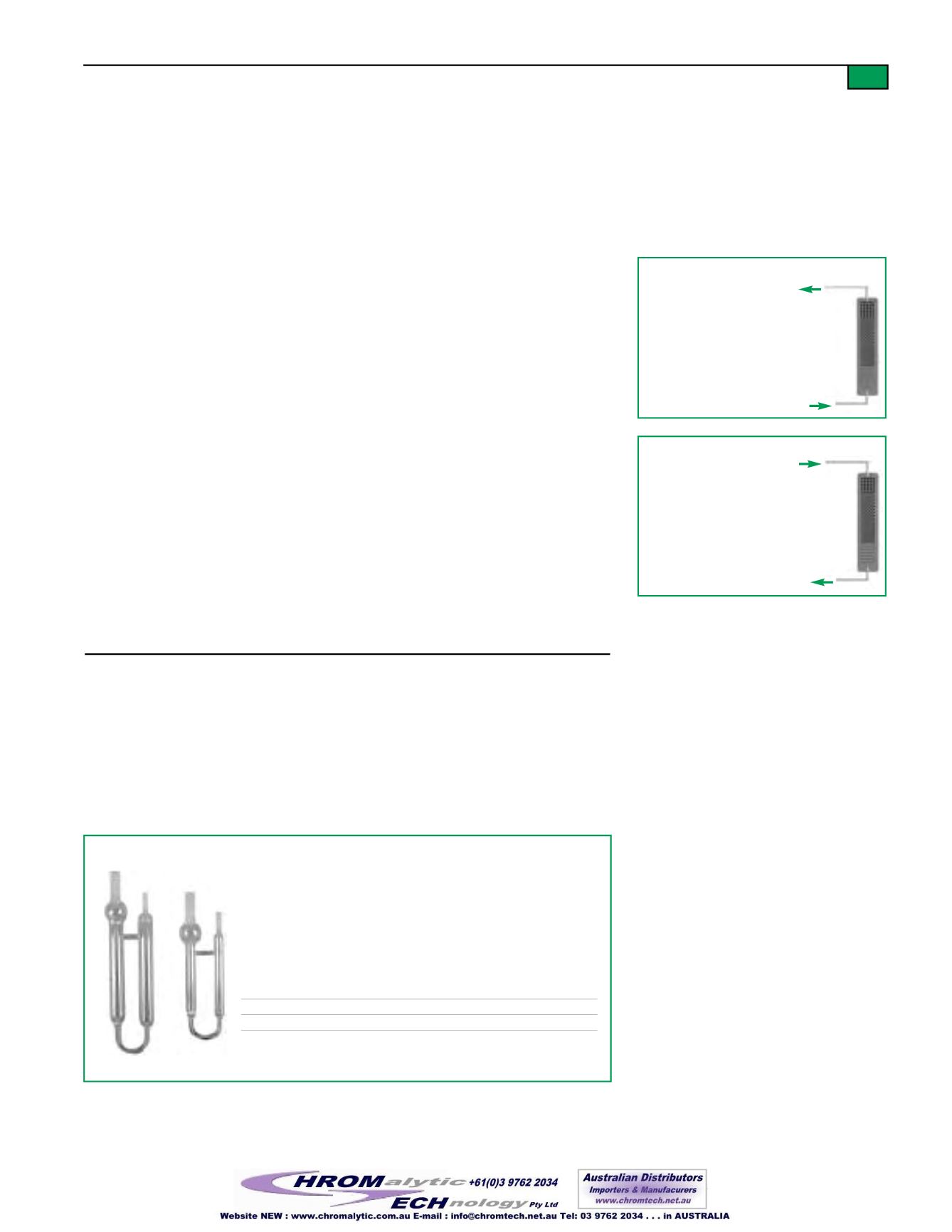
Figure 5.
Purge and trap frit spargers.
9
Purge and Trap Components
PurgeVessel
Three types of purge vessels (i.e., spargers) commonly are used in purge and trap systems.
Frit spargers (Figure 5) are used formost water samples. The frit createsmany small bubbles
that travel through the sample to increase purging efficiency. Fritless spargers are used for
samples that have high particulate content, or for industrial wastewater samples that may
foam. They create fewer bubbles, which decreases purging efficiency but eliminates plugged
frits and reduces foaming problems. Needle spargers are usedwhen purging soil, sludge or
solid samples.A narrow gauge needle is inserted into the sample and used to release a small
stream of purge gas. The two common sizes of spargers are 5mL and 25mL.
Step 5.
Desorb
•
Analytes are backflushed
into column.
•
Typical time: 2-4min.
•
Typical temp.: 180°-250°C.
•
Typical flow: 10-80mL/min.
Step 6.
TrapBake
•
Trap is baked cleanwith flow.
•
Typical time: 6-10min.
•
Typical temp.: 10-20°C
higher than desorb temp.
•
Avoid overheating adsorbents.
Step 5. Desorb
Once the desorb preheat temperature is reached, the purge and trap unit valve is rotated. This
directs the desorb (carrier) gas flow to backflush the adsorbent trap and carry the analytes in
a narrow band to theGC system. Figure 4 (page 7) shows the flow path of the desorbmode.
While the sample transfer occurs, the trap is heated to its final desorb temperature. Desorb
temperatures range from 180°C-250°C, determined by the adsorbent materials and themodel
of concentrator. The desorb flow rate is extremely important; it must be high enough to
ensure that the sample remains in a narrow band during the transfer to theGC column. The
optimum desorb flow rate for a purge and trap system is >20mL/min.; however, this flow
rate is too high to usewith capillary columns andmust be reduced to retain column efficien-
cy. The optimum flow rate for 0.53mm ID columns is 8-10mL/min. For narrow bore capil-
lary columns (0.18-0.32mm ID), the desorb flow rate usually is 1-2mL/min. when direct
interface is used. This low flow rate requires a longer desorb time due to the slow transfer of
the sample from the trap, which, in turn, creates awide sample bandwidth resulting in broad
peak shapes for all early eluting compounds. Cryofocusing (i.e., cold trapping) can be used
to reduce band broadening, by installing a secondary cold trap or by cooling theGC column
to subambient temperatures. The desorb time is inversely proportional to flow rate and trap
temperature, so that as the flow rate/trap temperature increases, the desorb time decreases,
due to the analytes flushing off the trap at a higher rate.Also, it is possible to desorb at high-
er flow rates (25-80mL/min.), when using narrow bore capillary columns, by using a split
injector to split the flow prior to the column (formore details on this technique see theGC
SystemConfigurations section, page 18).
Step 6. TrapBake
After the desorb step the trap is baked, with gas flow, to remove any remaining sample com-
ponents and contaminants from the trap in preparation for its next use. This step generally
lasts 6-10minutes; typical temperatures are 10-20°C above the desorb temperature. To pre-
vent damage to the adsorbent materials, do not exceed themaximum temperature of the trap.
Not recommended for wastewater samples because the samplemight
foam or the frit might become plugged.
Description
qty.
cat.#
5mL Fritted Sparger,
1
/
2
-inchmount
ea.
21150
25mL Fritted Sparger,
1
/
2
-inchmount
ea.
21151
• For Tekmar 2000, 3000, or 3100.
• Available in 5mL and 25mL sizes.
• Uniform frits ensuremaximum purge efficiency for
water samples.
• Manufactured to tight tolerances to ensure a leak-free seal.


